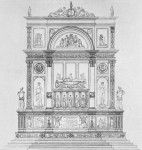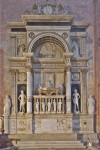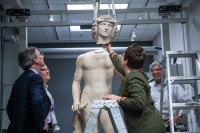 On the evening of Sunday, October 6th, 2002, the medium density plywood pedestal supporting the 15th century marble statue of Adam by Tullio Lombardo in the Velez Blanco Patio at the Metropolitan Museum of Art buckled. All 770 pounds, six feet three inches of Adam fell, hitting the ground hard and breaking into 28 large pieces and hundreds of small fragments. The head came off at the neck, the torso skidded across the floor, the right leg broke into six pieces, the left arm into seven. Nobody even heard the crash.
On the evening of Sunday, October 6th, 2002, the medium density plywood pedestal supporting the 15th century marble statue of Adam by Tullio Lombardo in the Velez Blanco Patio at the Metropolitan Museum of Art buckled. All 770 pounds, six feet three inches of Adam fell, hitting the ground hard and breaking into 28 large pieces and hundreds of small fragments. The head came off at the neck, the torso skidded across the floor, the right leg broke into six pieces, the left arm into seven. Nobody even heard the crash.
The catastrophe was discovered at 9:00 PM by a security guard doing his routine rounds. The emergency call went out to curators and conservators and the patio was cordoned off to allow for a forensic crime scene-level recovery of every little chip. The museum opened as usual on Monday, but nobody was allowed to photograph the disaster. The Met didn’t want the horror of the scene to be the image of the statue in people’s heads even after it was put back together. It took two days for the precise mapping of each fragment to be completed and all the pieces carefully bagged and tagged.
 Extensive damage to a sculpture is any museum’s worst nightmare — stone is much harder to repair than canvas — and this case was a particularly spine-chilling one because of Adam‘s singular importance. Commissioned for the tomb of the Doge Andrea Vendramin (d. 1478) in the church of Santa Maria dei Servi in Venice, Adam was the first monumental nude carved in the classical style since antiquity. The tomb, inspired by ancient triumphal arches, was recognized for the exceptional quality of its statuary before it was even completed. Venetian historian Marino Sanuto the Younger wrote in his diary in 1493 that the Vendramin funerary monument “will surely be the most beautiful in the world because of the excellent statues which are there.” Lombardo’s Adam was placed in a niche next to the sarcophagus of the Doge in the center of the monument. A matching statue of Eve (once attributed to Lombardo but now thought to have been the work of Francesco Segala) was on the other side.
Extensive damage to a sculpture is any museum’s worst nightmare — stone is much harder to repair than canvas — and this case was a particularly spine-chilling one because of Adam‘s singular importance. Commissioned for the tomb of the Doge Andrea Vendramin (d. 1478) in the church of Santa Maria dei Servi in Venice, Adam was the first monumental nude carved in the classical style since antiquity. The tomb, inspired by ancient triumphal arches, was recognized for the exceptional quality of its statuary before it was even completed. Venetian historian Marino Sanuto the Younger wrote in his diary in 1493 that the Vendramin funerary monument “will surely be the most beautiful in the world because of the excellent statues which are there.” Lombardo’s Adam was placed in a niche next to the sarcophagus of the Doge in the center of the monument. A matching statue of Eve (once attributed to Lombardo but now thought to have been the work of Francesco Segala) was on the other side.
The monastery and church of the Servi were demolished in 1812 in keeping with Napoleon’s edicts ordering the suppression of religious orders. The Vendramin tomb was rescued and installed in the choir of the church of Saints Giovanni e Paolo, but Adam and Eve never made it to the new location. Times had changed, and the classical nudes were now deemed to be not in keeping with the seriousness of the Christian religion. They were replaced by two warrior figures.
 The first man and woman were moved to the Palazzo Vendramin Calergi where they both remained until 1865 (Eve is still there today). That year the palace’s owner, Marie-Caroline de Bourbon-Sicile, Duchesse de Berry, daughter of King Francis I of the Two Sicilies and daughter-in-law of King Charles X of France, sold much of the contents of the palace at auction in Paris. Adam was acquired by collector Henry Pereire. After his death in 1932, it passed through the hands of a couple of dealers before being bought by the Metropolitan Museum of Art in 1936.
The first man and woman were moved to the Palazzo Vendramin Calergi where they both remained until 1865 (Eve is still there today). That year the palace’s owner, Marie-Caroline de Bourbon-Sicile, Duchesse de Berry, daughter of King Francis I of the Two Sicilies and daughter-in-law of King Charles X of France, sold much of the contents of the palace at auction in Paris. Adam was acquired by collector Henry Pereire. After his death in 1932, it passed through the hands of a couple of dealers before being bought by the Metropolitan Museum of Art in 1936.
The Met was thrilled to have it. Art historian Preston Remington, who was curator of the Met’s Renaissance Art department at that time, described Adam as “the most distinguished of Tullio’s sculptures” whose “importance to the collection of renaissance sculpture in the Metropolitan Museum is paramount.” Besides, he noted, “aside from its archaeological interest, the Adam is a work of great beauty and lasting charm.”
Key to that great beauty and lasting charm was the unblemished smoothness of the carving, perhaps Adam‘s most famous feature. If he couldn’t be put back together with that flawless surface, it would be an incalculable loss. Monumental Renaissance statuary doesn’t come up for sale very often, or ever, really; finding something of equivalent historical significance would be all but impossible.
 Initial prognostications were fairly optimistic: the damage was bad, but there were enough large pieces that conservators thought it could be fixed and returned to display in two years or so. That estimate was left in the dust. They decided to take a far more meticulous approach, studying every aspect of the reconstruction in detail before drilling holes in it and piecing it together with adhesives and pins. They stress tested the reversible organic adhesives to see if they could handle such a large statue. They discovered that fiberglass pins were better than metal ones because when they do break, they don’t take chunks of the marble with them. They used new laser imaging technology to create a 3D model so they could puzzle it out virtually before putting the physical pieces together. They even got a crappy copy of Michelangelo’s David and deliberately broke it in the same places Adam for testing purposes.
Initial prognostications were fairly optimistic: the damage was bad, but there were enough large pieces that conservators thought it could be fixed and returned to display in two years or so. That estimate was left in the dust. They decided to take a far more meticulous approach, studying every aspect of the reconstruction in detail before drilling holes in it and piecing it together with adhesives and pins. They stress tested the reversible organic adhesives to see if they could handle such a large statue. They discovered that fiberglass pins were better than metal ones because when they do break, they don’t take chunks of the marble with them. They used new laser imaging technology to create a 3D model so they could puzzle it out virtually before putting the physical pieces together. They even got a crappy copy of Michelangelo’s David and deliberately broke it in the same places Adam for testing purposes.
Instead of two years it took 12, but they were 12 years well spent. After all the work, all the research, was done behind closed doors, a secrecy that caused some comment as a new decade dawned with no publically visible progress, on November 11th, Adam is going back on display at the Met.
The story of the restoration is part of the exhibition. The statue, originally intended for a niche and therefore less worked in the back than in the front, will now be viewed in the round so people can see it the same way the conservators did. The Met has made some videos explaining the epic 12-year conservation project, and there will be an article about the process in the next volume of the Metropolitan Museum Journal (bookmark this page and check back for volume 49).
3D animation illustrating the order of assembly:
Time-lapse of the reconstruction: